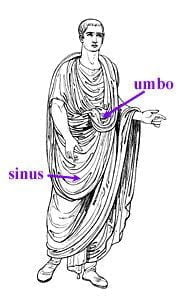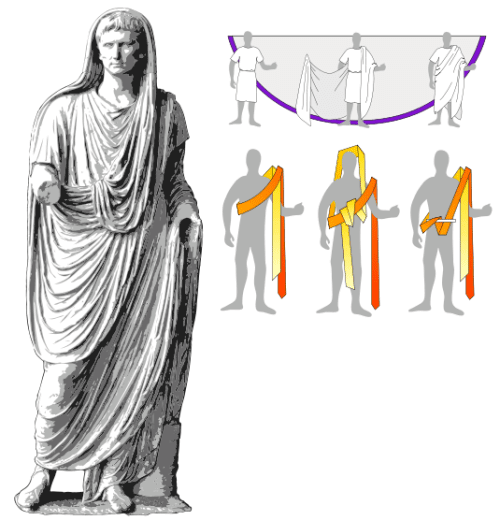The toga was a garment that distinguished Roman citizens, consisting of a 3- to 6-meter piece of cloth that was wrapped around the arms and body. Usually, the toga was made of wool (thicker or thinner) and was worn over the tunic. It was believed that the legendary King Romulus was a great supporter of wearing it.
Aulus Gellius, a 2nd-century Roman writer, claimed that no tunics were worn under the toga during royal times. The Romans themselves allegedly believed that both men and women wore toga at the beginning of Roman statehood. With time, however, a trend emerged among women to wear a table instead of a toga (except for high-class prostitutes, the so-called meretrices and women divorced because of adultery).
The toga was officially reserved only for Roman citizens who were compulsorily required to wear them during public ceremonies and holding office. Initially, the toga was practical, easy to make and put on the body. The toga was partially a rounded rectangular piece of cloth, usually white, which was wrapped around the body in successive layers. With time, however, its length increased and the cost of its implementation increased. This was largely due to the desire to increase draping, which also gave it a ceremonial character.
The name “toga” is probably derived from the word tegere, meaning “to cover”. The toga was so popular in the Roman world and distinguished the Romans from other free-born inhabitants that Martialand Virgil adopted to refer to the Romans as gens togata or togati. We can distinguish the following types of Roman toga:
- Toga exigua – the earliest toga, dating from the late republic. It was relatively simple, much shorter than the later versions. He was extremely favourable about her Cato the Younger.
- Toga virilis (“toga of a man”), also known as toga albaor toga pura –it was the most ordinary white toga worn over official occasions by an adult Roman citizen and a senator without a curule office (consul, praetor, aedile, censor or dictator). The toga was a symbol of maturity, citizenship, rights, freedom and responsibilities.
- Toga praetexta – a white toga with a wide purple stripe at the edge that was believed to have been borrowed from the Etruscans. This toga was worn over a tunic with two vertical stripes. It was founded by (1) curule magistracies (monarchs in the time of the kingdom); (2) free-born boys and some girls before they have reached the age of majority. It was believed that the wool from which it was made is a symbol of purity, legal protection and was supposed to repel evil magical powers; (3) some priests: pontiffs, augurs, epulones, Arval brothers.
- Toga candida (“light toga”) – an unusually white toga, wiped with chalk, worn by candidates (from the word candida, meaning “pure white”) for state offices.
- Toga pulla (“dark gown”) – worn by mourners; it could also be established during private misfortunes or social unrest. It is often used as a form of protest, incl. it was founded by some senators following the news of the expulsion of Cicero from the city.
- Toga picta (“colorful toga”) – a purple-colored toga with golden edges. It was worn on a similarly decorated tunica palmata. The toga was worn by a leader who was triumphant. During the empire, this dress was worn by emperors and consuls.
- Toga trabea – Associated with citizens of Equestrian origin. This garment was probably shorter than a typical toga and had a red or purple stripe.
- Laena – Suetonius describes it as a double toga, worn by Flamen priests. The garment was more like a heavy coat.
As already mentioned, togas were also worn by priests who conducted processions or celebrated ceremonies in them. It is worth mentioning that for the time of libation (making a sacrifice to the deity in the form of a precious liquid), making an offering, praying or carrying out auspices (making divine judgments from the flight of birds) the priests put a piece of toga fabric on the head, and over the head, forming a hood.
The toga also appeared in the Roman army, but certainly not in combat or as everyday clothing; more it was used as a coat or blanket, and in case of death of a companion, it was covered with it. In the army, instead of a toga, paludamentum (a woollen coat reaching the knees or below) or sagum (a warm coat used especially in the northern Roman provinces) was used as everyday clothes.
When wearing a toga, no pins, clasps or brooches were used, and the material wrapped around the body was to be arranged in successive loose layers. Sometimes tassels or balls were attached to the end of the toga to keep it properly positioned. Some togas – mainly during the Empire – had a pocket (sinus), i.e. a larger, loose layer of cloth wrapped from the left shoulder through the chest, below the other hand. Sometimes part of this layer was used to form another umbo(“bulge”) layer, which also served as a pocket. Along with the elongation of the material for the toga, the volume of the aforementioned pockets, which began to be used during the empire, increased.
Putting on a toga was difficult, not to say burdensome activity. The strip of fabric was folded lengthwise, one end was thrown over the left shoulder, a toga was placed over the back, the other end was passed under the right shoulder and thrown over the left shoulder from the front. To facilitate this extremely careful activity, richer citizens had a special slave for this purpose, called vestiplicus.
With the development of the Roman Empire, the importance of the toga decreased. In 212 CE, Caracalla granted citizenship to all free inhabitants your nationality, which made the toga have 40-60 million people carry the right. It was another step to the degradation of the toga that didn’t matter anymore. Higher nobles, holding high offices, commissioned the production of much more luxurious varieties of gowns. Christianity also had no little influence on the rejection of the toga. Christ’s followers saw in it an old pagan order that was unworthy. For example, pallium, a material that was easier to put on, was much more preferred.
In 382 CE, the Eastern Roman Emperor Theodosius I issued Lex Vestiaria, a law that degraded the toga and ordered equites to wear publicly in the Eastern Empire pallium, and by the senators paenula (hooded wool/leather coat). The Toga finally emerged from the canons of fashion in the 5th century CE with the fall of Rome.









